When it was built in 1977, Citicorp Center (later renamed Citigroup Center, now called 601 Lexington) was, at 59 stories, the seventh-tallest building in the world. You can pick it out of the New York City skyline by its 45-degree angled top.

But it’s the base of the building that really makes the tower so unique. The bottom nine of its 59 stories are stilts.
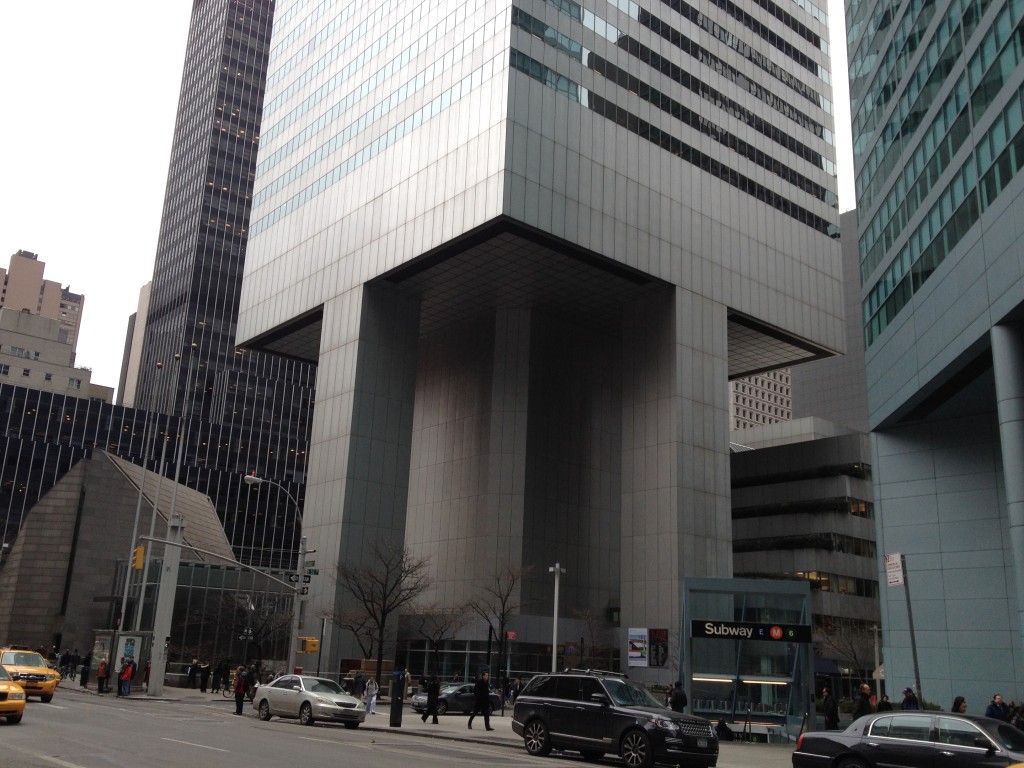
This thing does not look sturdy. But it has to be sturdy. Otherwise, they wouldn’t have built it this way.
Right?
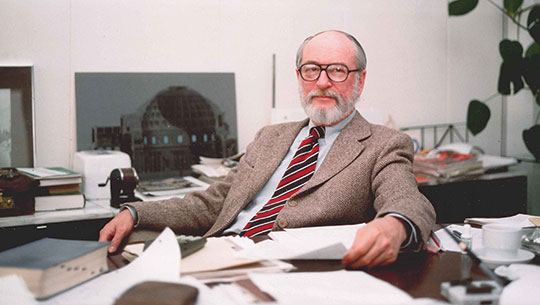
The architect of Citicorp Center was Hugh Stubbins, but most of the credit for this building is given to its chief structural engineer, William LeMessurier.
The design originated with the need to accommodate St. Peter’s Lutheran Church, which occupied one corner of the building site at 53rd Street and Lexington Avenue in mid-town Manhattan. (LeMessurier called the church “a crummy old building…the lowest point in Victorian architecture.” You can be the judge.)
The condition that St. Peter’s gave to Citicorp was that they build the church a new building in the same location. Provided that corner of the lot not be touched, the company was free to build their skyscraper around the church and in the airspace above it.
LeMessurier said he got the idea for the design while sketching on a napkin at a Greek restaurant.
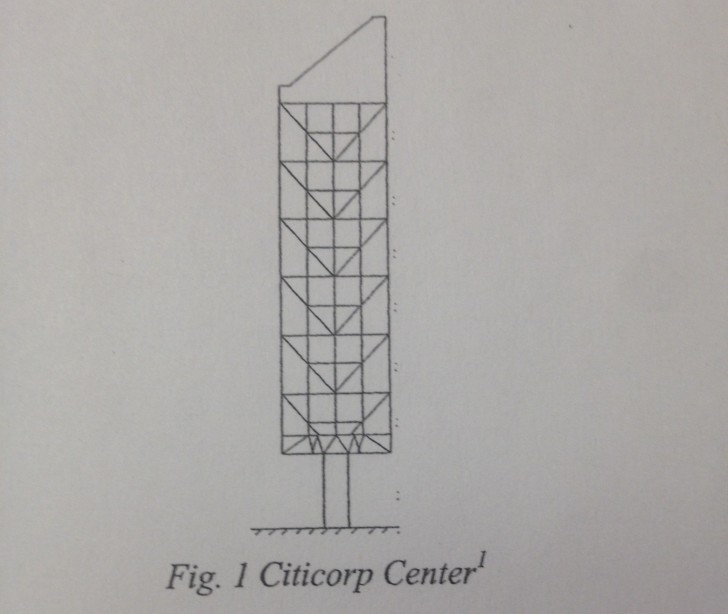
Here’s what’s going on with this building:
- Nine-story stilts suspend the building over St. Peter’s church. But rather than putting the stilts in the corners, they had to be at the midpoint of each side to avoid the church.
- Having stilts in the middle of each side made the building less stable, so LeMessurier designed a chevron bracing structure—rows of eight-story V’s that served as the building’s skeleton.
- But the chevron bracing structure made the building exceptionally light for a skyscraper, so it would sway in the wind. LeMessurier added a tuned mass damper, a 400-ton device that keeps the building stable.
It was an ingenious, cutting edge design. And everything seemed just fine—until, as LeMessurier tells it, he got a phone call.
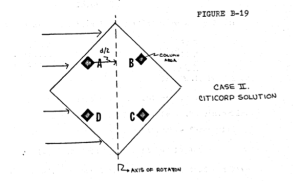
According to LeMessurier, in 1978 he got a phone call from an undergraduate architecture student making a bold claim about LeMessurier’s building. He told LeMessurier that Citicorp Center could blow over in the wind.
The student (who has since been lost to history) was studying Citicorp Center as part of his thesis and had found that the building was particularly vulnerable to quartering winds (winds that strike the building at its corners). Normally, buildings are strongest at their corners, and it’s the perpendicular winds (winds that strike the building at its face) that cause the greatest strain. But this was not a normal building.
LeMessurier had accounted for the perpendicular winds, but not the quartering winds. He checked the math and found that the student was right. He compared what velocity winds the building could withstand with weather data and found that a storm strong enough to topple Citicorp Center hits New York City every 55 years.
But that’s only if the tuned mass damper, which keeps the building stable, is running. LeMessurier realized that a major storm could cause a blackout and render the tuned mass damper inoperable. Without the tuned mass damper, LeMessurier calculated that a storm powerful enough to take out the building hits New York every sixteen years.
In other words, for every year Citicorp Center was standing, there was about a 1-in-16 chance that it would collapse.
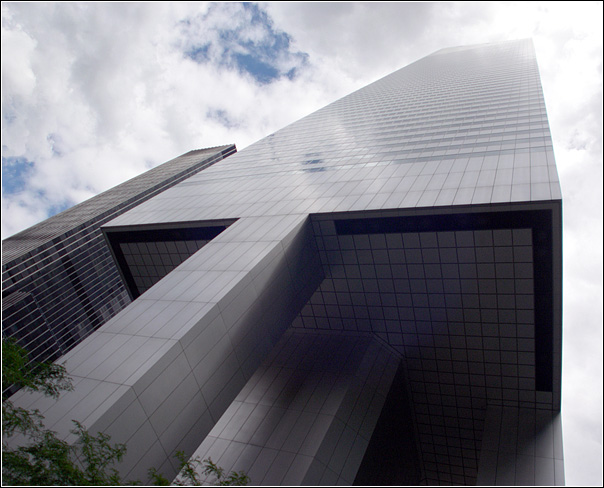
LeMessurier and his team worked with the Citicorp higher-up to coordinate emergency repairs on the building. With the help of the NYPD, they worked out an evacuation plan spanning a 10 block radius. They had 2500 Red Cross volunteers on standby, and three different weather services employed 24/7 to keep an eye on potential windstorms. They welded throughout the night and quit at daybreak, just as the building occupants returned to work.
But all of this happened in secret. Even as Hurricane Ella was racing up the eastern seaboard.

Hurricane Ella never made landfall. And so the public—including the building’s occupants—were never notified. And it just so happened that New York City newspapers were on strike at the time.
The story remained a secret until writer Joe Morgenstern overheard it being told at a party, and interviewed LeMessurier. Morgenstern broke the story in the New Yorker in 1995.
And that would have been the end of the story. But then BBC aired a special on the Citicorp Center crisis, and one of its viewers was Diane Hartley. It turns out that she was the student in LeMessurier’s story. She never spoke with LeMessurier; rather, she spoke with one of his junior staffers.
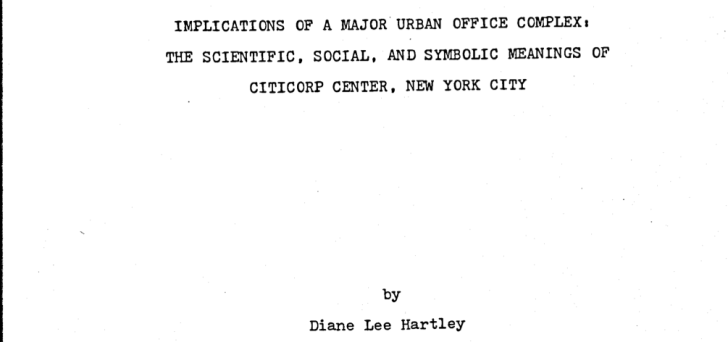
Hartley didn’t know that her inquiry about how the building deals with quartering winds led to any action on LeMessurier’s part. It was only after seeing the documentary that she began to learn about the impact that her undergraduate thesis had on the fate of Manhattan.

Reporter Joel Werner and producer Sam Greenspan spoke with Diane Hartley and Hartley’s thesis advisor David Billington. We also spoke with Michael Vardaro, who wrote the AIA Trust’s white paper about the case, and to LeMessurier’s former staffer Joel Weinstein.
Special thanks to Alan Bellows at Damn Interesting for suggesting this as a 99pi story, and to Simil Raghavan for helping us track down archival audio of William LeMessurier.



Comments (52)
Share
I love 99% Invisible, and this might be the best episode ever!
This was a perfect 99% Invisible story. Thanks to everyone for their hard work in bringing us this.
I’m having trouble visualizing the tower, could someone smarter than me post a “floorplan” that shows where all the supports are? It looks like there is something in the middle of the tower base?
As an engineer, I am always amazed at the extent to which architects will go to make excused for their art. Contrary to the statements at the end of the show, you cannot separate the structural problems from the architectural ones. If we were talking about some sort of abstract artwork, you may be able to make some sort of argument that, but for the fact that the building was endangering the lives of all its occupants and many of its neighbors, the artistry was amazing. BUT IT IS NOT AN ABSTRACT ARTWORK. It is a building with thousands of souls working and living in and around it. The Architect has an obligation first and foremost, not to his art, but to public safety.
Also, I reject the characterization that this story had a happy ending. There was no loss of life, but that was due entirely to chance. But for a series of lucky accidents, there would still be a dangerous domino threating the skyline of Manhattan. As it turns out, Mr. LeMessurier could hide the fig leaf that a design change from his original plan reduced the safety margin and that restoring his welded chevrons made the building safe again. But, this was only a happy accident. Let’s be clear. Those responsible for the safety of this building didn’t even do the right calculations to be sure the building had sufficient safety margins. It was little more than luck that welding the bolted joints was a sufficient solution to the problem.
In the case of the Citi Center Building, the architects chose an innovative design that required a structure that went against thousands of years of conventional wisdom with respect to the design of tall structures. Good on them, except, they failed to do the necessary calculations to be sure that the building was safe. This is a failure, pure & simple.
99PI, now I am looking at you. Framing this story as anything but an epic fail is an epic fail on your part.
Here’s the structural of the building: http://www.architecture-illustration.com/Line-%20diagrams/Citicorp_Center-diagram.jpg
and here’s Google search results for “CIti corp center”” https://www.google.com/search?q=the+structure+of+citicorp+center&newwindow=1&es_sm=122&tbm=isch&imgil=UlHsDzHjMKS-GM%253A%253Bhttps%253A%252F%252Fencrypted-tbn0.gstatic.com%252Fimages%253Fq%253Dtbn%253AANd9GcRdaw9-WUblbBIl7njXZ6jwayJNrqIjzaf92LptSj-5hHqEyvy4%253B265%253B195%253B_43XuWK4AnJJ_M%253Bhttp%25253A%25252F%25252Fwww.pbs.org%25252Fwgbh%25252Fbuildingbig%25252Fwonder%25252Fstructure%25252Fciticorp.html&source=iu&usg=__AaXAeJ3_WFX2zvTNZSIFUHhTAug%3D&sa=X&ei=jNFRU4uwEtWfyATamIAg&ved=0CDQQ9QEwBQ#facrc=_&imgdii=_&imgrc=lTg0ZAW9fVzYvM%253A%3B13J8bI9Ech9XRM%3Bhttp%253A%252F%252Fimg13.imageshack.us%252Fimg13%252F8118%252Fimg0665pz.jpg%3Bhttp%253A%252F%252Fwww.skyscrapercity.com%252Fshowthread.php%253Ft%253D1527008%3B478%3B640
As a former architecture student, I absolutely love this episode. And I lover 99% Invisible. I can’t share this episode enough.
Good jobs guys and thank you.
The chevron shaped steel frame – seen in the sketch above – is at the perimeter of the tower and the center of it is taken up by the elevator/service core – which also helps hold the building up.
In between them is column-free office space.
The link will take you to an image of the floor plan with descriptions of where the structure is.
https://www.flickr.com/photos/47256924@N05/14001911215/in/set-72157644291748115
I agree with Mr. Johnson above. Mr. LeMessurier did a upstanding job taking swift action to fix the problem, What he did should be praised in ethics courses. But his firm made a significant error which endangered lives. I can see how a non-engineer can frame this story as happy ending, but in my world people get fired for negligence like this.
I would be curious to know if LeMessurier was penalized by the Engineering Board of NY for this calculational oversight.
I disagree.
A student alerted the engineer to a problem with the design. The engineer listened, then went to the client, admitted to the problem. The engineer then went to find a way to solve the problem. Whilst a solution was being found, steps and procedures were put in place to deal with the worse case scenario of a building collapse. In my mind this is an engineer acting ethically.
It is important to understand that there was not a fundamental problem with the design of the structure, but rather during construction the connections for the diagonal beams were changed from welded to bolted, at the request of the contractor, and approved by the engineer. In hindsight that request should not have been approved, but that does not automatically imply negligence of the engineer.
In my mind the engineer would have been negligent if they were acting outside their area of competence, which they were not. The engineer would also be negligent if they ignored recognised design standards, or if they didn’t follow proper checking and peer review processes.
The other possible avenue of negligence would be if the engineer ignored the problem when it was brought to their attention, or tried to shift the blame onto someone else. The engineer however accepted responsibility for the problem and took actions to fix the problem.
About the only thing to my mind that should have been handled differently was the removal of the secrecy surrounding the rectification work. But can you place the blame for that at the engineer? I am doubtful that the engineer would have had much control over the secrecy adopted.
“It is important to understand that there was not a fundamental problem with the design of the structure, but rather during construction the connections for the diagonal beams were changed from welded to bolted, at the request of the contractor, and approved by the engineer. In hindsight that request should not have been approved, but that does not automatically imply negligence of the engineer.”
The fact that the building was safe “as designed” (welded) was due to little more than luck. Read the New Yorker Article. Mr. LeMessurier had not done the calculations for a wind from a corner. In normal designs this is not necessary (because in normal designs, the worst case loading is a perpendicular wind), but Mr. LeMessurier wasn’t doing a normal design was he? Because he was doing an unusual design, he (and all those around him) had an obligation to carefully explore the normal set of calculations and see if the normal assumptions apply (and to think of new cases as well).
They did not do this. The first time he did the calculations (according to the New Yorker article) was in order to show this pesky student just how wrong they were.
I repeat myself, but I cannot see this as anything but an epic failure of the architecture and engineering communities. This building was not safe by design. It was safe by accident.
It should be told over the campfire or at conferences or wherever scary stories are told to young engineers and architects to keep them on the straight and narrow.
Definitely one of the best episodes on 99%
The TV Show “Numb3rs” > Season 1 > Episode 4 “Structural Corruption” retells a fictionalized version of this story, but it has a lot of facts right and real computer models of the quartering winds twisting that would happen. Worth a watch after hearing this episode.
Just visited this place during my lunch break. It really is breathtaking. I spent a good 10 minutes just ogling. It’s a shame what folks take for granted. What an amazing structure.
Incredible episode!
New favorite episode!
This was the first 99pi story I’ve listened to, and it was fantastic!
Although not specifically highlighted, the engineers who take a look at Figure B-19 of the thesis (posted, above) will see the fundamental calculation error: calling out the distance from the column to the axis of rotation as ‘d/2’. With ‘d’ typically referring to the length of the diagonal of the floor plan, the correct distance should have been called out as ‘d/4’. This may well have resulted from applying the formula for calculating overturning moment in convention structures (i.e., with columns at the corners, or ‘d/2’ from the axis of rotation) rather than thinking through how the formula should be derived given the unique structure (i.e. twice the column section, but each located ‘d/4’ from the axis of rotation). This was my point of debate with LeMessurier’s project engineer, who asserted that the structure was ‘more efficient’ in ways that I failed to understand.
Sam here, producer at 99% Invisible. I just found out that my mom worked at Citicorp Center from 1979-1981 and was there during the secret renovations! Thanks Diane!
As a structural engineer myself, I was fascinated by this episode. In response to comment #11 above, the figure d/2 must be referring to half the distance between columns, as measured perpendicular to the axis or rotation shown. Moreover, what you say is true “With ‘d’ typically referring to the length of the diagonal of the floor plan”, then the distance from the corner to the building would be d/2. Thus, by the Pythagorean theorem, half the distance between the columns would be SQRT(d)/2, not d/4.
Could you please post a figure showing how you came up with your answer? I’m no engineer, but I am curious. I proved (to myself at least) that the distance from a column to the axis of rotation shown is indeed d/4. If d is the diagonal, and the columns lie at the midpoint of each side, then line AB forms (with the top corner) a triangle similar (in the geometric sense) to the triangle formed by the horizontal diagonal and the top corner of the building. Because the diagonal is d, and the columns lie at the midpoint of a side, length AB is d/2. The distance from the midpoint of AB (which lies on the axis of rotation) to the column is half of d/2 = d/4. Could you please explain to this curious one WHY that is not so? Thanks in advance.
In response to curious one: I guess the confusion comes from the fact that we are using different assumptions. I realize now you are assuming “d” is the diagonal across the floor plan of the building. That is why you get the correct value of d/4 as the distance between the column and the axis of rotation. I was usind “d” as the dimension of the building itself on the side. But in defense of the original engineer who drew the picture, I think he denoted “d” as the distance between the columns and not as a function of the building dimensions. Sorry for the confusion.
Thank you for taking the time to respond to my question. Perhaps we should both defer to Ms. Hartley’s comment at #11 above for the proper interpretation of the figure, as she is presumably most familiar with the source material.
However, I still have a small issue with your original comment. If we assume d is the length of a side, then the indicated distance is still not sqrt(d)/2. That is what caught my eye in your original post–I couldn’t understand where the ‘sqrt(d)’ term would come from. I couldn’t quite follow what you were saying well enough to try the math on my own, so I figured I’d ask you! Regardless, by the pythagorean theorem, if d is the length of a side of the building, the indicated length is d/2sqrt(2).
Am I missing something else?
Again, I appreciate you taking the time to reply. Thank you.
From the New Yorker Aritcle:
“LeMessurier had long since established the strength of those braces in perpendicular winds–the only calculation required by New York City’s building code. Now, in the spirit of intellectual play, he wanted to see if they were just as strong in winds hitting from forty-five degrees. His new calculations surprised him.”
Again, once more with FEELING, he had not even DONE a vital calculation to know his building was safe. He had turned an age old design practice on its head by putting the columns in the middle of the sides rather than at the corners. Okay this is fine, live outside the box all you want, you clever guy. BUT, then you don’t get to lean back in your chair collecting awards for your cleverness if you used shortcuts (such as “the worst case wind loading condition is when the wind hits a wall broadside”) that depend on living INSIDE the box. It was on him and all those around him to be 100% sure that living outside the box was safe in this case. Clearly, he didn’t do that.
I think it is also important to remember that the bolt vs. weld on the chevrons is a complete red herring. If they had followed his design to the letter, it STILL would have been nothing but luck that kept the building from falling down. He didn’t KNOW it was safe until well after the building was standing atop the NYC skyline.
Mr. LeMessusier deserves our scorn. Engineers and Architects alike should denounce him for having such ill regard for the public safety.
I just now realized that the title of the Episode is a pun. I propose a new, better title: Structural Failure
I work at Citi and find “Episode 110: Structural Integrity” a great read. I’m sharing it on the internal blog. Thanks.
On the surface, this story seems a stuffy piece of esoteric academic and scientific history. However, I’m fascinated by the amount of baggage that was stuffed into it. Besides the obvious form versus function debate, there are embedded points made on gender discrimination and if you don’t fear the bends of deep sea exploration, I’m sure finance and nationalism play a crucial part in this tragic comedy. Back in WW2, the Japanese used to fly planes in US warships, 13 years ago Muslims flew jetliners into the.world trade center. My point is that through overt hostility or subtle negligence, New Yorkers should be adamant about this nearly averted disaster.
But everything’s been resolved for now so I’d imagine there’s nothing to worry about and no need to be nervous anymore. The tuned mass damper point is important. I’m too lazy to look closely, but the calculations being discussed are taking into account a functioning tmd or in the event of power failure?
I’m having a hard time determining what is being said on account of what is being said (no, not necessarily how, you read that right braniac).
I saw the original episode and even though not an engineer was appalled that a joint change from wield to bolt was granted without consulting the original designer. Further that cornering winds were not considered when even a non-engineer can see that cornering winds would put enormous strain on the building with the non-standard mid stilts.
A frightening expose to say the least. I wonder how many other architectural flaws there are hidden around the city just waiting for disaster to occur. Having worked across the street at 399 Park Ave. also Citibank, and occasionally in Citicorp Center, one never knows that one’s life could be in so much danger.
The Tacoma Washington bridge of the 50s comes to mind. That design didn’t plan on the winds and the resonance they can setup. Good catch by the student and kudos for the architect for not letting his ego get in the way. When I received a D in Statics and dynamics in college, I knew civil engineering was not for me.Great story.
Thanks for the history… and just the story. You guys are doing great job…
On rare occasions, I have to park the car and listen carefully to a story on the radio. Yesterday was one of those occasions.
My life’s story includes an engineering design that failed. The failure didn’t kill any humans, but did cause a major penalty to the client. I did my best to prevent the failure, but I was unable to do so.
The project was the main wastewater treatment plant for a large city. I was a staff engineer for a corporation that was consultant to the city. I was assigned to review the basic design calculations for the project. The design was by one of the most brilliant engineers in the world, within that particular specialty. However, I spotted serious gaps in the project as designed. I argued with that brilliant engineer for some 8 hours over the course of a week. My superiors refused to take me sufficiently seriously, the plant was built the way they wanted, and the plant was unable to clean the wastewater enough to meet the requirements. Eventually, an additional process was added to the treatment plant so that it could produce water that was good enough to discharge. This retrofit cost many millions of dollars – I don’t know how many – and I suppose some fish died, although not any humans. The retrofit was paid for by taxpayers and/or the city’s customers. As for me, I was fired for “poor engineering judgement” long before the plant was actually built. Forces of ego contributed mightily to the failure.
So when I heard the Citicorp Center story yesterday, I did indeed need to stop, write down some details, and learn more.
— Oaklandguy, Apr. 18, 2014
Tell us more! Write to sam[at]99pi.org
I love how almost every episode makes me want to visit the blog to see what’s being talked about. The stories stand on their own, but the site is a great bonus feature. Thanks for the amazing work.
Very familiar with this story and building, and was excited to hear about the recent update!
I worked across the street from Citicorp for 14 years (@ 909 3rd), and wasn’t worried as was mentioned in the podcast that it could “topple sideways in the wind …” Oh no. I worked across the street diagonally, which I thought was the way the building would have fallen.
And thanks for using my picture in the blog. Glad to contribute here.
Nice episode, classic 99pi. But my one takeaway was a wish that Diane Hartley not only got credit for the insight she had versus some bland, half-forgotten story of a male architect (because they’re all male), but also that she felt she had more right to be *right*! Kudos to her professor for seeing her impact.
What happened to the church? Looking at Google Streetview, it seems like the church is gone.
I think it is the building with the diagonal roof line on the SE corner of E 54th and Lexington
https://www.google.com/maps/@40.759147,-73.970873,3a,75y,151.21h,86.32t/data=!3m4!1e1!3m2!1sRy0h2dCAJr9dpvRyxxwjOg!2e0?hl=en
Question for the readers of this page,
Doesn’t anyone else think it is cowardly on the part of Roman, Sam & the rest of the 99PI folk not to take an explicit stand on this issue?
Roman often talks about architecture in the grandest terms. They should have taken a side on this very important issue.
Even if they were not courageous enough to speak in their own voice, where was the voice denouncing Mr. LeMessurie for his obvious failing in this affair. Surely they could have found some engineer to be somewhat critical of the fact that he failed to do a fundamental calculation necessary to ascertain the safety of his design until after his building would have toppled had the wind not been favorable to him and to point out that in such a case it is shameful for him to hide behind his claim that repairs that added the necessary margin of safety was little more than returning the building to his original design? Surely they could have found this voice. But they didn’t because they didn’t look for this voice and thereby they took a definite side in the matter. The wrong side.
Roman & the 99PI show takes sides all the time. They took sides in this case by not presenting any voice (easily found, do not say otherwise) deservedly denouncing Mr. LeMessurier’s colossal mistake. They have done a disservice not only to their listening audience but to engineers & architects worldwide.
Regards,
Joe J.
P.S. I get that this building is amazing to behold. It is stunning. I gasped when I first looked at the pictures of it from a Google image search. I want this to be a great building. And, it is. Now. By the grace of God and not much else. It should have been great by design from before it was built. It was not and, as such, we should hold those responsible up as examples of the dangers of being blinded by pride in our own cleverness. JJ
I do not know what Mr. Mars’s background is, but I doubt he is a licensed engineer. And as such I do not expect him to see the world through our lens. I don’t expect him or many others to see this as an engineering failure (which was 100% owned up to). Mr. Mars is a wonderful story teller and most people will view this story as Mr. Mars does. Let “them” have it their way and let the engineers keep doing our thing in the background.
No I don’t think it is “cowardly”. I think they are looking at this through their lens and we through ours.
PS – wonder if the state board punished Mr. LeMessurier?
Yes, perhaps you are right. The Engineering Culture, in general, and that of Professional Engineers, in particular, has at its core the idea that every engineer has a duty to the public first and foremost — even above duty to their paying clients. The public cannot judge if a boiler will blow up, if an appliance will electrocute them, if a dam will burst or if a bridge will fall. We are in a position of trust, and even more so that doctors, we must not let the public down.
And yet, I am quite disappointed in Roman and the 99PI gang as I feel they have a duty to the public as well.
I feel strongly that they should have found a Professional Engineer (or actually almost ANY engineer based on those I work with and around) to condemn this clear lack of due diligence on the part of Mr. LeMessurier.
Joe J.
Great listening to this story, heard about this once before, but never got the full explanation. I hate to do it but I am going to:
Guess he only LeMessurier’d once.
I created an album on my Flickr site of scans of the original engineering and design drawings for Citicorp Center.
They further illustrate the design innovations and almost tragic human error of planning only for perpendicular wind loads.
The illustrations come from two books published about the Stubbins firm published decades ago and long before the public was notified of the engineering issues.
Flickr Album: https://www.flickr.com/photos/47256924@N05/sets/72157644291748115/
Books: http://www.worldcat.org/title/hugh-stubbins-and-his-associates-the-first-fifty-years/oclc/14579119
http://www.worldcat.org/title/hugh-stubbins-architecture-in-the-spirit-of-the-times/oclc/14696358
Oh, man, that was an fantastic story-telling for an incredibly well produced episode. Congrats Roman, his producers and everyone involved. Fascinating story.
Hi Roman / Sam,
This was I think your best episode so far this year. It’s a great story, but it left me very unfulfilled. How could such a serious and seemingly simple mistake be made in engineering? How common are such mistakes? Also your story makes LeMessurier sound like a hero, but I think the ethical issues are not at all that clear cut, for example see this analysis: http://www.crosscurrents.org/kremer2002.htm
You did an episode before about the ethics of building prisons. I think this is well-worthy of a follow-up episode examining these issues, rather than just resting on the happy luck stemming from the random questions of a student.
But wait – theres more! You might want to check out the Useless Information podcast. There’s another student who says they were the one …http://uselessinformation.libsyn.com/ui-75-the-citicorp-tower-revisited
To Mr. Johnson, I would like to point out that you do not know all the facts. The New Yorker article did not get all the facts straight. I think its wise not to believe everything you read. There is a reason you are not finding others to agree with your condemnation of my father.
This was a great episode, thank you!
A fascinating story, and one that I was familiar with since I was heavily involved in the wind-tunnel model testing of that building in Canada in the early 1970s. Those tests were carried out in 1973-4 (not in 1978 as implied by the BBC story..) and reported by the University of Western Ontario to Le Messurier & Associates in 1975 (with preliminary results issued in 1974). In the tests the wind direction was varied every ten degrees, and the structural response of the building to ‘quartering’ winds could have been determined from them. However, apparently the New York Building Code of the time was used instead; that Code assumed that wind only blew at right angles to a wall of a building. The wind-tunnel tests also studied and reported on the wind forces across the wind – an important consideration for very tall buildings.
While the late Bill LeMessurier is to be commended on his integrity in revealing the errors in the building design and structure, there was some obligation for him to read a report commissioned by his own company at the time it was issued, rather than using an outdated building code for such an important structure. Also even without reading that report, it should have been obvious that hurricane winds could blow in any direction with respect to the walls of any building in Manhattan.
The 1973-4 wind tunnel testing also studied in detail the performance of the ‘tuned mass damper’ (400 tonnes of concrete at the top of the building) which I understand has performed successfully over the life of the building in reducing the wind-induced vibration in non-hurricane winds.
It was a Princeton University student doing a senior thesis!
I work on a corporate campus that has a number of TV screens to display messages and occasionally, quotes from our founder. I realized recently that this building is the background for one of the quotes:
“We like individuals who are broad minded enough to respect the other person’s point of view regardless of his personal convictions.”
I wish I could fulfill whichever designer created that image by telling them that I’m finally understanding this deep cut.
Why do they say that there was a 1/16 chance the building would come down each year; doesn’t that assume a 100 percent chance that a blackout would render there tuned mass damper inoperable every year?
a recent re-analysis using modern computer technology has concluded that the building’s ORIGINAL design would have been fine – it was not more susceptible to quartering winds than perpendicular winds – https://europepmc.org/article/MED/34195696